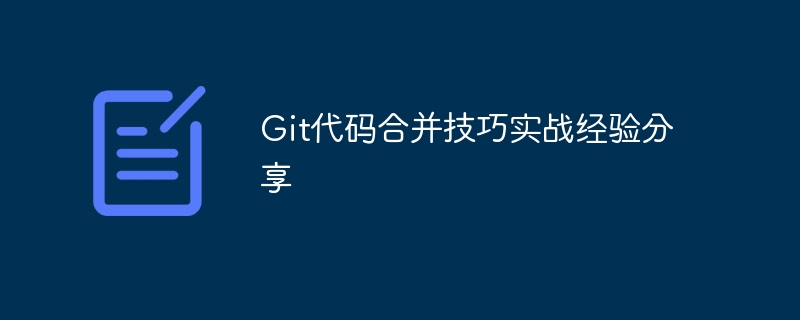

Git code merging skills and practical experience sharing
Git is one of the most popular version control systems currently, and many developers use Git to manage their code bases. In a multi-person collaborative development environment, it is often necessary to merge codes from different developers. However, code merging can lead to conflicts and other problems, especially when large-scale code changes involve multiple branches. This article will share some Git code merging tips and practical experiences to help developers better handle code merging issues.
The first rule of thumb is to make sure your code base is up to date before merging code. This can be achieved by using the git fetch command, which pulls the latest code from the remote repository. Then use the git merge command to merge these latest changes into your own branch. This avoids conflicts caused by the code base being out of sync.
The second rule of thumb is to conduct a code review before merging the code. Code review is a very useful practice that can help identify potential problems and errors and provide feedback and suggestions. By conducting code reviews, code changes that may cause conflicts can be discovered and resolved early, thereby reducing problems during the merge process.
The third experience is to use Git's rebase command to merge code. The rebase command applies a series of commits to another branch, creating a linear commit history. Compared to using the merge command, using the rebase command can create a clearer and simplified commit history. However, it should be noted that using the rebase command may cause conflicts, especially when multiple branches jointly modify the same piece of code. Before rebasing, make sure to back up your local code and resolve conflicts during the merge process.
The fourth experience is to use Git's interactive rebase command (git rebase -i) to edit the submission history. By using the interactive rebase command, commits can be reordered, merged, and deleted. Using this command can help you better organize your commit history and better organize your code logically. However, be aware that editing the commit history may introduce new problems and conflicts, so make sure to back up your local code before doing this.
The fifth rule of thumb is to use the --no-ff option to merge when using Git's merge command. The --no-ff option creates a new merge commit even if the merge is conflict-free. The advantage of this is that you can clearly see the merge point of the code in the submission history, instead of ignoring the existence of the merge like the default fast-forward merge. This can better trace the evolution and changes of the code, which is very useful especially for large-scale code changes and multi-person collaboration development projects.
The sixth lesson is that when conflicts occur, resolve them promptly. Conflicts are a common problem encountered in code merging, especially when multiple developers make modifications to the same file at the same time. The key to conflict resolution is communication and cooperation. Before resolving conflicts, it is recommended to communicate with other developers to understand each other's intentions and goals. Then, by carefully reviewing and modifying the conflicting code, resolve the conflict and retain the correct changes. Finally, conduct code testing and verification to ensure that the conflict resolution code works properly in various scenarios.
Through the above practical experience and skills, we can better handle the problems and challenges in Git code merging. Code merging is an inevitable part of multi-person collaborative development. By handling code merging reasonably and correctly, the team's development efficiency and code quality can be improved. Most importantly, communication and cooperation during the merge process are also very important. By sharing and sharing experiences, we can make progress together and better cope with the challenges of code merge.
The above is the detailed content of Git code merging skills and practical experience sharing. For more information, please follow other related articles on the PHP Chinese website!
 Build your own git server
Build your own git server
 The difference between git and svn
The difference between git and svn
 git undo submitted commit
git undo submitted commit
 How to undo git commit error
How to undo git commit error
 How to compare the file contents of two versions in git
How to compare the file contents of two versions in git
 pscs5 installation serial number
pscs5 installation serial number
 What file is mydrivers
What file is mydrivers
 Is it necessary to upgrade windows 11?
Is it necessary to upgrade windows 11?
 What are the methods for docker to enter the container?
What are the methods for docker to enter the container?




